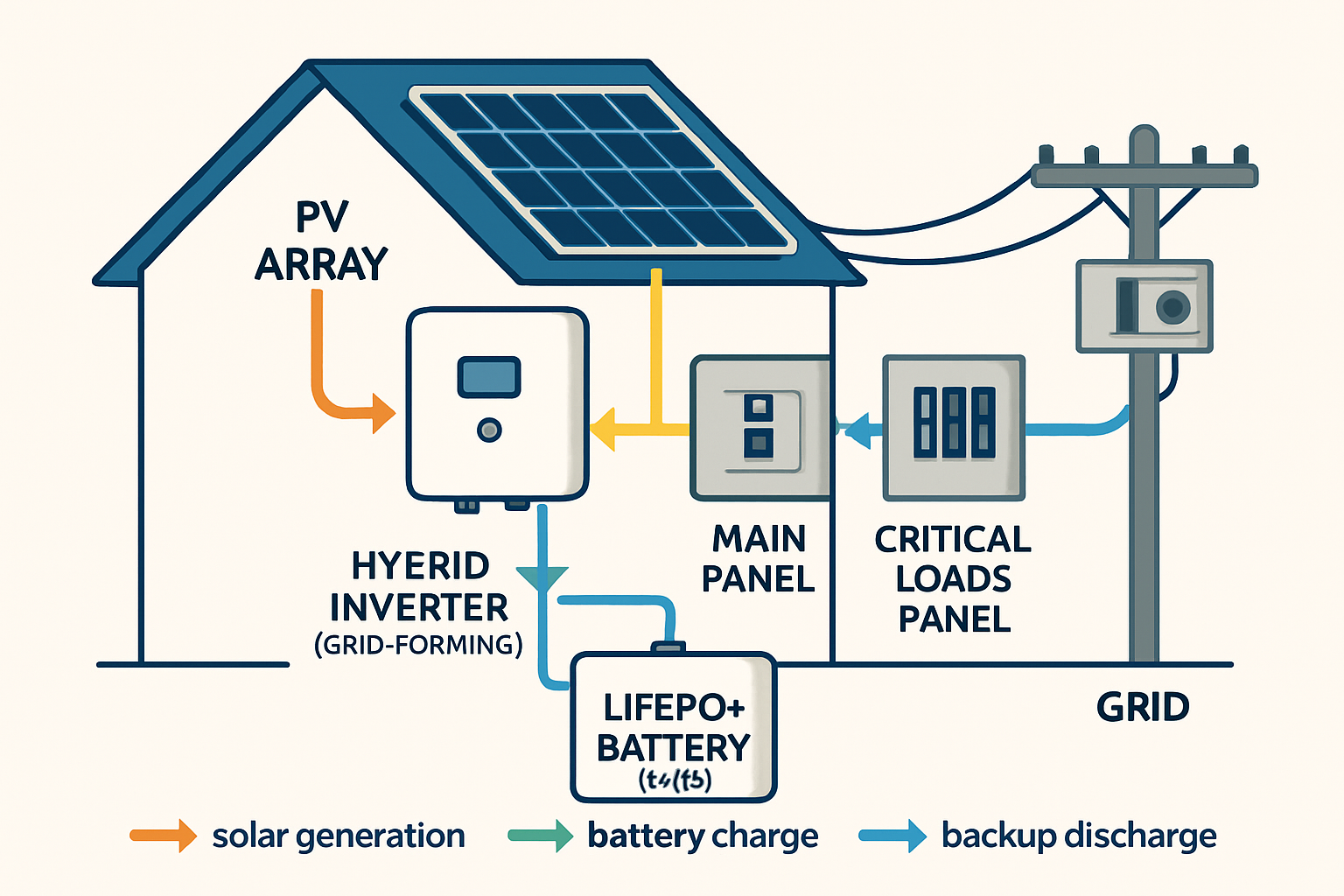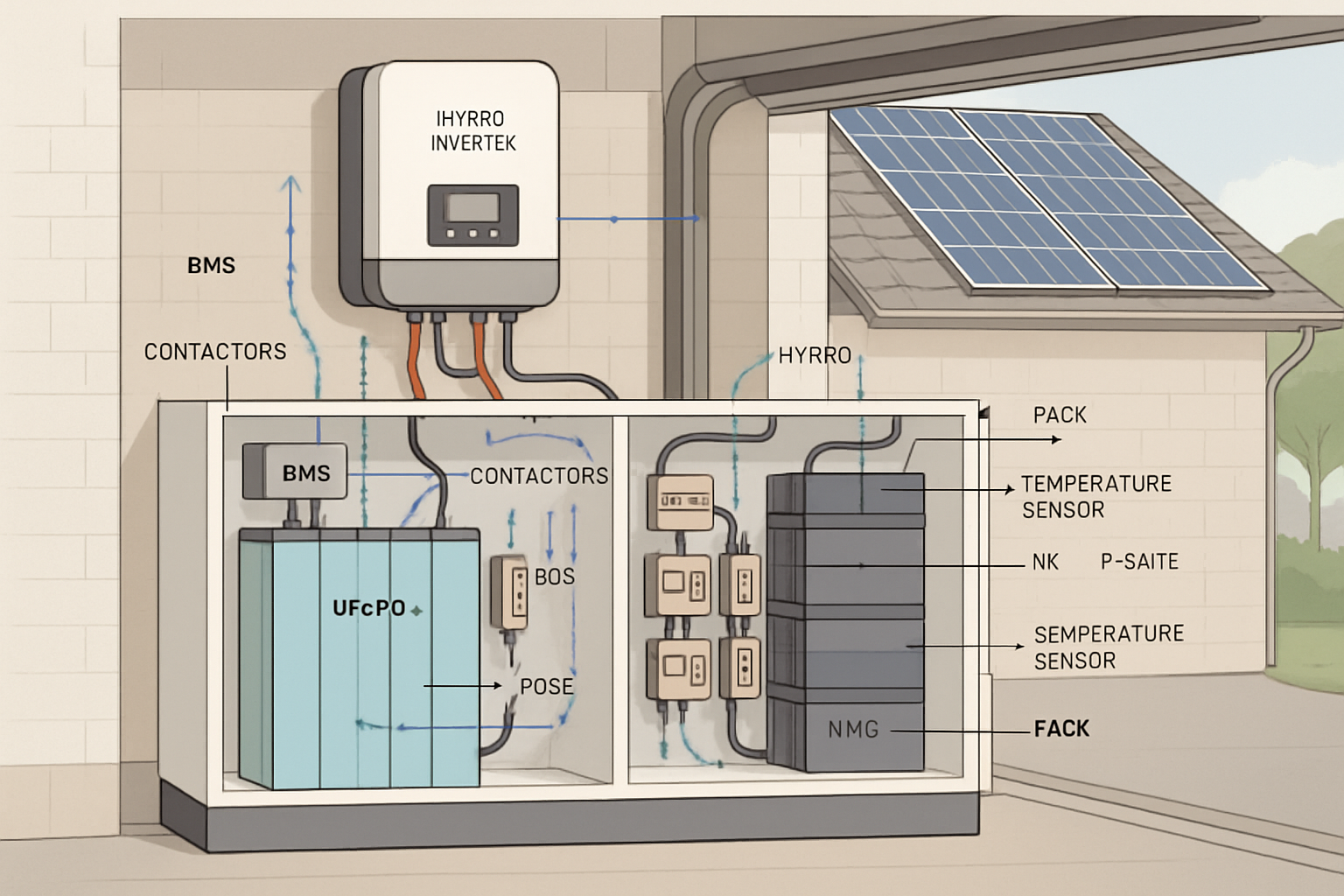Why these Solar FAQs matter
Solar myths linger. They slow down smart energy choices and raise doubt about reliability, cost, and practicality. This page brings together Solar FAQs, strips out confusion, and provides solar power facts backed by respected sources. You will see what holds up and what does not.
Across grids and homes, data shows solar works at scale, pairs well with storage, and delivers stable energy over decades. As a team with long experience in lithium batteries and energy storage systems (ESS), we focus on solutions that are safe, modular, and scalable.

Snapshot: What credible research says
- Grid integration challenges are manageable with proven tools such as flexible generation, demand response, smarter grids, and transmission. Storage helps but is not the only lever, especially at early penetration levels, according to the IEA’s Getting Wind and Solar onto the Grid and the System Integration of Renewables update.
- PV costs fell steeply over the last decade. Average utility-scale PV levelized cost dropped about 85% from 2010 to 2021, per IRENA’s Renewable Power Generation Costs.
- Solar deployment can scale to high shares with a portfolio of storage, transmission, and load flexibility, as summarized on the U.S. DOE Solar Futures Study page.
- Solar works in many climates, including cold and cloudy regions. See EIA’s Solar Explained for basics and performance context.
Myths vs facts at a glance
The table below distills several recurring solar energy myths and the evidence-based counterpoints.
| Myth | Fact | Source |
|---|---|---|
| Solar needs 1:1 backup from conventional plants | Diverse flexibility (fast-ramping plants, demand response, storage, and grids) reduces any need for dedicated 1:1 backup | IEA grid integration report |
| Storage is mandatory at low solar shares | Early-stage integration often needs little to no storage; other tools manage variability | IEA SIR update |
| Solar is still too expensive | Global utility-scale PV costs fell ~85% (2010–2021), improving competitiveness | IRENA cost report |
| Panels stop working on cloudy or cold days | Output continues in diffuse light; cooler temperatures can improve efficiency | EIA Solar Explained |
| High solar shares destabilize the grid | Standards, smart inverters, and operating practices keep systems stable | IEA Next-Generation VRE |
| Solar only suits sunny regions | Reliable output depends on annual irradiance, system design, and siting—not just heat | DOE solar energy topic |
12 persistent myths answered
Myth 1: Variability makes solar unmanageable
Grid operators already handle variable demand and plant outages daily. Solar’s weather-driven variability fits into that toolkit. Better forecasting, geographic diversity, flexible generation, and demand response keep systems balanced. The IEA System Integration of Renewables paper groups these measures as modern power system essentials.
Myth 2: Solar requires 1:1 backup capacity
It does not. A mix of flexible assets covers the residual net load, not a mirror copy of PV capacity. The IEA highlights how grids use faster ramping plants, interregional transmission, and demand shifting to reduce backup needs.
Myth 3: Storage is a must at low solar penetration
Storage is powerful, especially at higher solar shares or for resilience. Yet early-stage PV integration typically relies more on flexibility, grid operations, and modest transmission upgrades. The IEA documents many systems that added sizeable PV with little storage at first, then layered storage as value grows.
Myth 4: Solar does not work in cold or cloudy climates
Solar produces in diffuse light. Many systems yield 10–25% of peak output under heavy clouds, and more during bright overcast. Cold air can improve panel efficiency because PV cells like lower temperatures. See EIA’s Solar Explained for climate basics that influence yield.
Myth 5: Solar panels only last 10 years
Modern modules typically carry 25-year performance warranties. Annual degradation rates often average around the half-percent range, depending on technology and climate. DOE’s PV basics page notes long service lives for quality modules; see DOE PV Technology Basics.
Myth 6: Solar is still too expensive to be practical
Costs have fallen fast thanks to scale and technology gains. IRENA reports about an 85% drop in utility-scale PV LCOE from 2010 to 2021. Soft-costs and local policies matter, but the technology itself is far more affordable than a decade ago.
Myth 7: Solar hurts grid stability
With smart inverters, voltage and frequency support improve. Grid codes, ride-through standards, and better controls keep systems stable even at higher shares of inverter-based resources. The IEA Next-Generation Wind and Solar work describes the “cost-to-value” shift and the role of modern distribution grids.
Myth 8: Solar cannot power homes at night
Grid-tied systems draw from the grid after sunset and export during the day. Add a battery and you shift daytime solar into night. Today’s home ESS use lithium iron phosphate (LiFePO4) cells with high cycle life and strong thermal stability, paired with hybrid inverters that manage PV, battery, and loads. The DOE Solar Futures Study page outlines how storage supports higher solar shares.
Myth 9: Inverters waste too much energy
Modern inverters are efficient. Quality units reach 95–98% efficiency under typical loads. Features like maximum power point tracking (MPPT), low standby draw, and advanced grid support further improve net yield. See DOE’s overview of inverters and power electronics.
Myth 10: Manufacturing emissions erase the climate benefits
Lifecycle studies show PV’s total footprint is far below fossil-fired generation per kWh. Emissions during manufacturing are offset early in the project life for most installations. The IEA’s technology tracking on Solar PV summarizes PV’s growing role in clean generation portfolios.
Myth 11: Solar takes too much land
Rooftops, carports, brownfields, and disturbed sites absorb a large share of projects. Ground-mount arrays can co-exist with grazing and pollinator habitats. The Solar Futures Study page highlights siting strategies and transmission planning that support high deployment with balanced land impacts.
Myth 12: Maintenance is constant and costly
PV has no moving parts. Routine checks, occasional cleaning, and inverter replacement within the project life are typical. Predictive monitoring reduces truck rolls. DOE’s solar topic hub links to best practices that keep O&M simple.
Technical notes for better design and performance
Efficiency and yield
- Module efficiency: many mainstream panels deliver ~20–22% under standard test conditions. Higher-efficiency modules help where roof space is tight.
- Temperature coefficient: choose modules with a low negative coefficient (e.g., −0.3%/°C to −0.4%/°C) to retain power on hot days.
- Inverter loading ratio (DC/AC): values around 1.1–1.3 often raise annual energy capture without clipping too much at noon peaks.
Storage that fits the job
- Battery chemistry: LiFePO4 is known for thermal stability and long cycle life. Good for daily cycling in home ESS.
- Duration: 2–4 hours suits time-of-use shifting and evening peaks. Longer durations target outage coverage or deeper peak shaving.
- Control strategy: hybrid inverters prioritize self-consumption, backup reserve, or bill optimization based on tariffs and site goals.
Grid integration tips
- Smart inverters: enable volt-var, volt-watt, and frequency-watt. These features support local voltage and reduce feeder stress.
- Forecasting and demand response: simple automation like pre-cooling or EV smart charging aligns loads with solar output.
- Phased upgrades: as the IEA grid integration manual notes, treat integration as an evolutionary process. Add tools as solar share rises.
Real use cases
Home with time-of-use rates
A 7 kW rooftop array with a 10 kWh LiFePO4 battery shifts late-afternoon solar into evening peaks. The hybrid inverter limits grid imports in high-tariff hours and maintains a small reserve for outages.
Farm or off-grid cabin
Panels, an MPPT charge controller or hybrid inverter, and a modular battery bank serve daily loads. A generator can cover rare extended storms. This setup reduces fuel use and noise, yet keeps autonomy high.
Small business with demand charges
Solar trims daytime energy costs. A right-sized battery clips short spikes that drive demand charges. Remote monitoring tracks state of charge, PV yield, and inverter status for proactive maintenance.
Where the momentum came from
Public and private efforts accelerated PV learning rates. The DOE EERE success story notes decades of work that lowered costs, raised module efficiency, and expanded financing options.
Key takeaways
- Solar energy myths often ignore modern grid practices and proven technologies.
- Solar myths debunked by data: costs are down, reliability is up, and integration is practical.
- Pair PV with the right inverter and a LiFePO4 ESS to boost resilience and savings.
- Use smart design: size DC/AC well, enable inverter grid support, and plan O&M.
- Follow reputable sources for Solar FAQs and solar panel efficiency myths, such as IEA, IRENA, EIA, and DOE.
References
- IEA. Getting Wind and Solar onto the Grid. https://www.iea.org/reports/getting-wind-and-solar-onto-the-grid
- IEA. System Integration of Renewables. https://www.iea.org/reports/system-integration-of-renewables
- IEA. Next-Generation Wind and Solar Power. https://www.iea.org/reports/next-generation-wind-and-solar-power
- IRENA. Renewable Power Generation Costs in 2021. https://www.irena.org/publications/2022/Jul/Renewable-Power-Generation-Costs-in-2021
- U.S. DOE. Solar Futures Study. https://www.energy.gov/eere/solar/solar-futures-study
- EIA. Solar Explained. https://www.eia.gov/energyexplained/solar/
- U.S. DOE. Inverters and Power Electronics. https://www.energy.gov/eere/solar/inverters-and-power-electronics
- U.S. DOE. Solar Photovoltaic Technology Basics. https://www.energy.gov/eere/solar/solar-photovoltaic-technology-basics
- IRENA. End-of-life management: Solar Photovoltaic Panels. https://www.irena.org/publications/2016/Jun/End-of-life-management-Solar-Photovoltaic-Panels
- IEA. Solar PV (tracking). https://www.iea.org/reports/solar-pv
About our solutions
We design reliable and scalable energy systems to help customers reach energy independence. Core offerings include:
- LiFePO4 lithium batteries for stable, safe daily cycling
- Integrated home ESS combining batteries, hybrid inverters, and PV
- Off-grid solar packages for homes, farms, and cabins
- High-quality solar inverters to convert DC to AC with strong grid support





Leave a comment
All comments are moderated before being published.
This site is protected by hCaptcha and the hCaptcha Privacy Policy and Terms of Service apply.